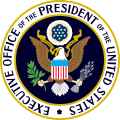This article cites its sources but does not provide page references .(July 2017) |
 | |
| Agency overview | |
|---|---|
| Formed | 1946 |
| Preceding agencies | |
| Headquarters | Eisenhower Executive Office Building |
| Employees | About 35 |
| Agency executive |
|
| Parent agency | Executive Office of the President of the United States |
| Website | wh |
The Council of Economic Advisers (CEA) is a United States agency within the Executive Office of the President established in 1946, which advises the president of the United States on economic policy. [2] The CEA provides much of the empirical research for the White House and prepares the publicly-available annual Economic Report of the President. [3] The council is made up of its chairperson and generally two to three additional member economists. Its chairperson requires appointment and Senate confirmation, and its other members are appointed by the president.

































